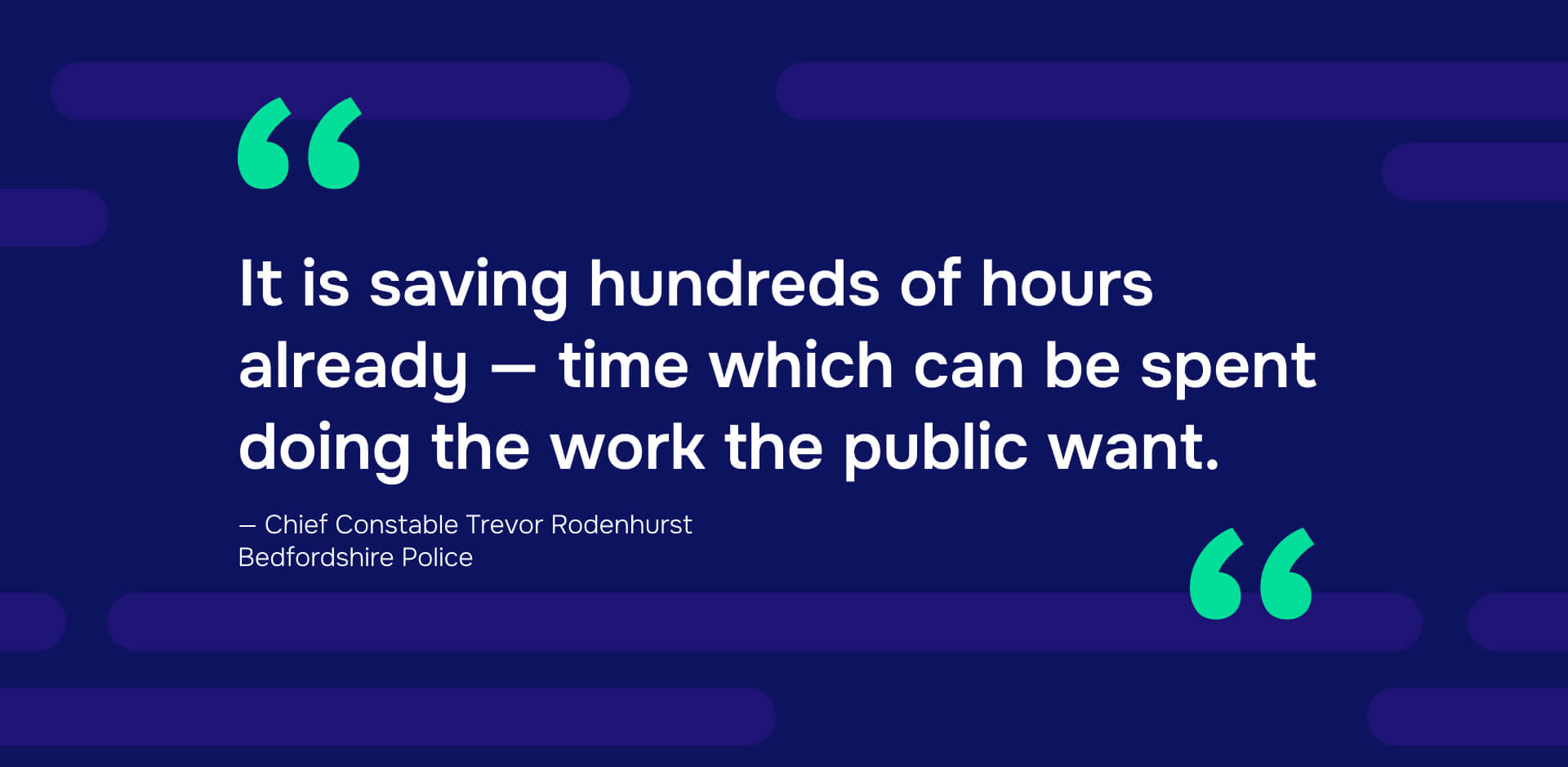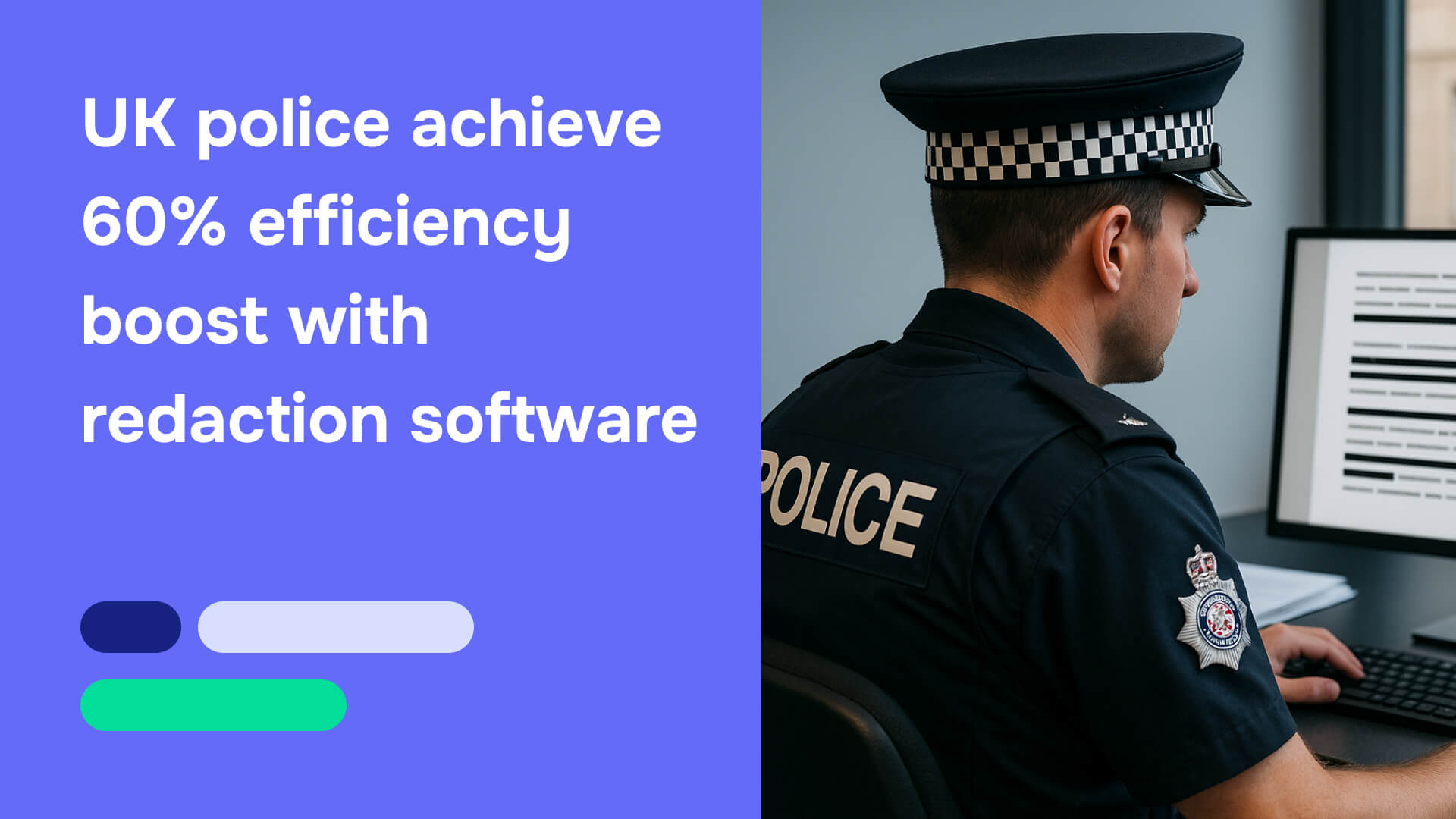British police currently spend 770,000 hours annually on manual text redaction, with 210,000 of those hours wasted on cases that never reach prosecution. That's the cost of manual redaction in UK policing - officers buried in administrative work while court backlogs hit 73,105 cases and victims wait years for justice. Bedfordshire Police found a way out, and the UK government just validated it with £230 million in funding.
The UK government's Accelerated Capability Environment conducted a comprehensive review of police redaction software across 16 police forces. The finding: automated redaction can deliver a 60 percent efficiency boost for policing. More importantly, UK police forces are already proving it works.
This is the story of how proven police redaction software, government backing, and pioneering forces are transforming one of policing's most time-consuming tasks into a manageable, efficient process.
Bedfordshire Police use case: The first implementation
Bedfordshire Police became the first UK force to deploy AI-powered police redaction software in June 2023. The implementation wasn't experimental - it was a calculated response to unsustainable workload pressure.
The Accelerated Capability Environment conducted demonstrations of six different commercial off-the-shelf tools with varying maturity levels, reviewing speed and accuracy for each. Bedfordshire tested solutions across 200+ documents during their May 2023 pilot, achieving 92 percent accuracy in identifying sensitive information.
The documented results transformed daily operations:
- 578-page phone download: Reduced from multiple days to 20 minutes. A detective constable called it a "game changer" - work that previously consumed an entire shift now completes before the shift even starts.
- 806-page document: Completed in one hour versus a full work shift to process half the document manually.
- 350,000-cell Excel spreadsheet: Finished in 30 minutes instead of four hours.
Once fully embedded, Bedfordshire projects annual savings of 9,525.60 hours of police and staff time. That's nearly five full-time positions freed to focus on actual policing rather than administrative redaction.

Chief Constable Trevor Rodenhurst stated: "This is another example of where technology can make a real difference to policing. It is saving hundreds of hours already, time which can be spent doing the work the public want - being out in our communities preventing crime and keeping people safe."
The Policing Minister recognized the achievement at the 2023 APCC & NPCC Partnership Summit, demonstrating that police department redaction automation works in real policing environments, not just pilot programs.
Read also: UK police lose 770,000 hours annually to manual redaction
Government backing and national framework
The success at Bedfordshire didn't happen in isolation. UK government investment and infrastructure development created the conditions for police departments to modernize their redaction processes.
Spring Budget 2024 investment
The Spring Budget 2024 allocated £230 million for police technology modernization, with automated redaction specifically listed as a priority area. Minister of State Chris Philp emphasized the impact: "Investment that will go towards innovation such as artificial intelligence, including automatic redaction and translation, and will enable police to spend less time in the office, and more time in our communities."
This wasn't vague future planning - it was immediate funding for proven solutions.
Police Digital Service Framework
The Police Digital Service established a £10 million Text Redaction Framework covering four years (2024-2028). A few approved suppliers passed evaluation against over 250 requirements including cyber security, FOIA compliance, and ease of use.
The framework simplifies procurement dramatically. Instead of lengthy tender processes requiring specialized legal and technical expertise, police departments can access vetted police redaction software through a streamlined process. This removes a major barrier that previously prevented smaller forces from modernizing their redaction capabilities.
Accelerated Capability Environment review
The ACE review engaged 16 police forces in evaluating six commercial off-the-shelf tools. The comprehensive assessment identified both capabilities and limitations, noting trade-offs between speed and accuracy across different solutions.
The review concluded that "AVMM technology could be transformational for policing and implementing effective technology and efficient operational processes will be critical to realising this full potential." This validation from a government innovation unit carries weight—it's not vendor marketing, it's independent evaluation.
What is the technology behind 60% efficiency gains?
Police redaction software handles what manual processes struggle with: scale, consistency, and speed. When Bedfordshire cut a 578-page document from days to 20 minutes, they didn't upgrade their technology - they eliminated the bottleneck keeping cases from moving forward.
AI-powered detection across evidence types
Modern police redaction tools use natural language processing and machine learning to scan evidence the way officers would—if they had unlimited time and perfect consistency.
The technology identifies names, addresses, phone numbers, and email addresses across documents regardless of format. It catches social security numbers, national insurance numbers, and financial account details buried in spreadsheets or PDFs. Dates of birth, medical information, and sensitive identifiers scattered throughout evidence files—all flagged automatically.
For visual media, the technology detects faces in video footage, license plates in body-worn camera recordings, and even transcribes audio while identifying personal information in speech. What once required frame-by-frame review now happens in minutes.
Security without compromise
Technology meeting Police Digital Service accreditation standards ensures data never leaves controlled environments—critical for evidence handling. Full audit trails document every redaction decision, who made it, when, and under what authority. This satisfies both legal requirements and operational accountability needs.
The systems integrate with existing case management platforms rather than forcing entirely new workflows. Officers maintain override capabilities—automation handles bulk processing while preserving human judgment for complex decisions requiring context.
The human element remains critical
No automated system runs entirely without oversight. The ACE review identified that maturity varies between speed and accuracy across different tools. Video redaction solutions remain less mature than text-based systems.
Officers need training to understand tool limitations and when to override automated decisions. Quality control through systematic review processes remains essential. AI bias and accuracy require ongoing attention.
The goal isn't replacing human judgment - it's amplifying it with tools that handle routine identification while officers focus on nuanced decisions requiring investigative context. Think of it as freeing detectives from clerical work so they can do detective work.
Read also: Personal information list: Types and PII examples
Why efficiency gains matter: court backlogs, victim impact, and officer morale
The time savings matter, but the downstream effects matter more. Faster redaction doesn't just free up hours - it keeps investigations moving, victims informed, and cases progressing toward resolution.
When redaction delays collapse justice

The Crown Court backlog tells the story in numbers: 73,105 cases in September 2024, up from 33,290 in March 2019. The Public Accounts Committee's verdict: "Justice delayed is justice denied."
RASSO prosecutions now take over two years on average to reach trial. Many victims find the court process as traumatic as the crime itself. Others simply withdraw. The Committee specifically flagged postponed hearings on scheduled days—the circumstances that distress victims most.
The remand crisis compounds the damage. One in twenty defendants on remand had been waiting over two years. Some walked free upon sentencing, having already served their sentence length while awaiting trial.
Faster redaction attacks this bottleneck directly. A 578-page phone download that takes 20 minutes instead of days means cases move forward. Officers not buried in administrative work means disclosure happens on schedule. Evidence reaching prosecutors promptly means trials don't collapse.
The ripple effects: fewer postponements, fewer victim withdrawals, fewer remand backlogs.
What faster processing actually changes
The ACE review documented benefits that extend beyond raw time savings. Criminal justice outcomes accelerate when redaction no longer creates weeks-long delays. Officer morale improves—administrative burden decreases while time for prevention-focused community work increases. Force workflows standardize. Redaction policy gains clarity and consistency.
Standardized practices also improve collaboration between police and Crown Prosecution Service. CPS rejections due to incorrect or insufficient redaction decrease. Evidence quality improves. Audit trails satisfy disclosure obligations more thoroughly.
Multi-jurisdictional investigations benefit when forces use compatible systems rather than each operating with different approaches that create coordination friction.
The infrastructure exists - implementation is the question

Bedfordshire documented the efficiency gains. The UK government validated the technology and allocated £230 million. The Police Digital Service created procurement infrastructure.
The question isn't whether police redaction software works - it's how quickly forces will implement it.
From 578 pages in days to 20 minutes. From nine hours per 60 minutes of video to under four hours. The efficiency boost isn't theoretical - it's documented, validated, and ready for deployment.
Bedfordshire's 9,525.60 projected annual hours saved multiplies to hundreds of thousands of hours across 43 forces in England and Wales. That's capacity returned to actual policing - officers in communities instead of trapped at desks.
The Police Digital Service framework simplifies procurement. Government funding removes budget barriers. For forces exploring solutions, the national framework provides vetted suppliers meeting Police Digital Service standards. Direct options like Redactable offer similar AI-powered capabilities with 98 percent time savings, automatic PII detection, and compliance with security requirements.
Somewhere tonight, an officer will spend eight hours redacting a document that could take 20 minutes. A victim will wait another month for disclosure. A case will age past the point where witnesses remember clearly. The solution exists. The gap is adoption.





